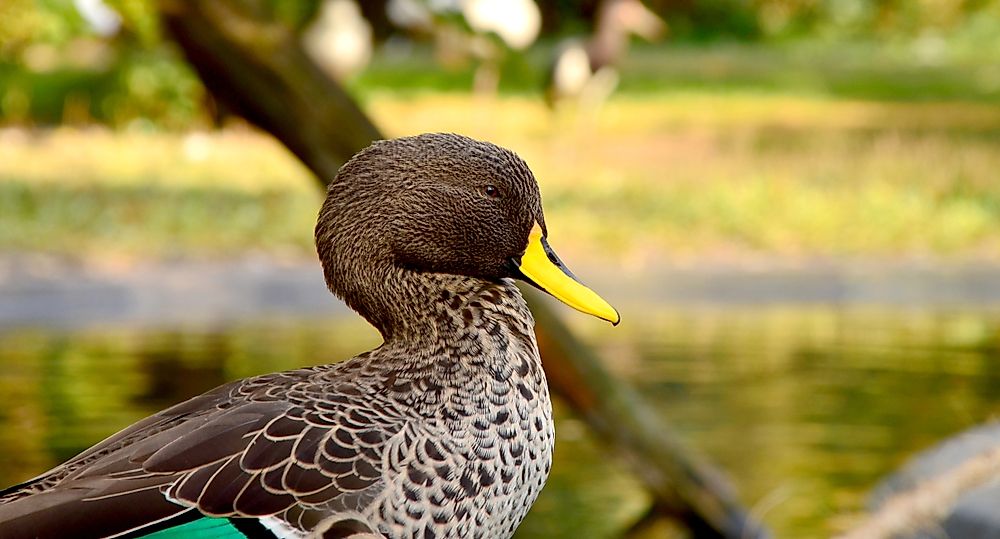Endangered Endemic Birds Of Madagascar

Madagascar is the fifth largest island in the world, and is found located off of the southeast coast of Africa. It experiences a tropical climate along the coast, temperate inland and arid climate in the south. It has a vast range of biodiversity including several species of birds. Some of the Madagascan biodiversity is threatened by extinction. The Madagascan Fish Eagle and the Madagascan Porchard are the island nation's two most threatened endemic birds.
Madagascan Pochard (Aythya innotata)
The Madagascan Pochard is a medium-sized bird. The male is chestnut brown with brown flanks and a white belly. The under tail is white with a white bar on the wing. It has gray feet, beak, and legs and the eye iris is white. The female bird is dull compared to the male and lacks the white iris. The juvenile resembles the female but its paler brown. It inhabits shallow freshwater lakes and marshes and areas with open waters and dense vegetation. The bird is endemic to Madagascar with a single location of Lake Alaotra. The bird occurs singly or in pairs and sometimes may form flocks. It breeds in September and January around the vegetation sites at the edges of the lake. The female lays 6 to 9 eggs and incubates them for 26 days after which they hatch. The young ducklings are brown above and yellowish beneath and on the face. It dives underwater for aquatic plants and invertebrates which serve as its food. The bird was extinct since 1991 and recently sighted in 2006. It is a critically endangered species according to the International Union for the Conservation of Nature's (IUCN) Red List of Threatened Species. The main threat to this bird is the range of environmental changes, agricultural practices, pollution, and siltation. Madagascar declared the rediscovery location of the bird, Lake Alaotra a land of national importance and efforts to conserve the habitat of the birds are underway.
Madagascan Fish Eagle (Haliaeetus vociferous)
The Madagascan fish eagle is the largest raptor in Madagascar. It is dark reddish-brown with whitish cheeks and throat and a white tail. It ranges along the west coast from Morombe to Diego in the north. One population occupies the northwest coast region, and another occupies the inland Antsalova region in its west-central area. It lives in estuaries, marine islands, mangroves, the freshwater lakes, and rivers in the Antsalova region. The bird breeds from May to October and has a maximum clutch size of two, but only one bird per nest survives. Most of the birds practice polyandry where one female mates with more than one male. It exclusively feeds on fish and catches its prey by snatching fish on the water surface. It is also a critically endangered bird on the IUCN Red List. Major threats include habitat degradation and human persecution. Its location is a site of international importance. There is also a Madagascan fish-eagle conservation program in place.
Meller's Duck (Anas melleri)
The bird has a brown plumage with brown flecks and streaks. It has a green patch with white borders on the wings. Its beak is gray, its eyes are dark brown, and its feet are orange-brown. It inhabits freshwater bodies in forested areas. The birds walk in pairs or small groups of up to 12 individuals. They form larger flocks when feeding or roosting. It feeds on freshwater foods including vegetation, seeds, and mollusks. Breeding season ranges from September to April. The female bird lays one egg per day until they reach five to ten. She incubates for 26 to 28 days as her male partner remains nearby. Listed as endangered, the bird faces threats like habitat degradation and loss and hunting pressure. Madagascar breeds the birds in seven protected areas and has enacted legislation inhibiting hunting of the birds.
Bernier's Teal (Annas Bernieri)
Bernier's teal is a small, delicate-looking bird. It has a light reddish-brown plumage with buff colored throats and chin and a pink-grey bill. Its wing has a black patch with white borders. In wet season they inhabit the wetlands, and in dry seasons they occupy shallow water bodies. Other locations include sandbars and mangrove forest edges. It occurs in small groups that feed during the day and night. It feeds on invertebrates and plants in the water. It breeds in the wet season and nests in cavities in trunks of the black mangrove trees. The bird is threatened by conversion of wetlands to agricultural farms in Madagascar. Conservation programs have initiated captive breeding of the species.
Conservation of Madagascar's Avian Biodiversity
Faced with the threats of extinction, Madagascar continues to protect its endemic endangered birds through such efforts as captive breeding, legislation, and declaration of their resident locations as sites of national importance. Also, it restricts the international trading of the endangered species under Appendix two of the conservation programs. Among the endangered birds of Madagascar are Van Dam's Vanga Bird (xenopirostris damii), the Slender-Billed Flufftail (sarothrra watersi), and the Sakalava Rail (Amaurornis olivieri)
Endangered Endemic Birds Of Madagascar
| Endangered Endemic Birds of Madagascar | Scientific Name |
|---|---|
| Madagascan Pochard | Aythya innotata |
| Madagascan Fish Eagle | Haliaeetus vociferoides |
| Meller's Duck | Anas melleri |
| Bernier's Teal | Anas bernieri |
| Madagascan Serpent Eagle | Eutriorchis astur |
| Sakalava Rail | Amaurornis olivieri |
| Slender-Billed Flufftail | Sarothrura watersi |
| Van Dam's Vanga | Xenopirostris damii |











